Today we share the second report in our series of findings from the Gender Balance in Computing research programme, which we’ve been running as part of the National Centre for Computing Education and with various partners. In this £2.4 million research programme, funded by the Department for Education in England, we aim to identify ways to encourage more female learners to engage with Computing and choose to study it further.
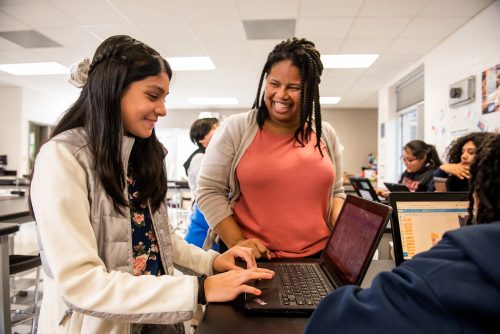
Previously, we shared the evaluation report about our pilot study of using a storytelling approach with very young computing learners. This new report, again coming from the Behavioural Insights Team (BIT) which acts as the programme’s independent evaluator, describes our study of another teaching approach.
Existing research suggests that computing is not always taught in a way that is engaging for girls in particular [1], and that we can improve this. With the intervention at hand, we wanted to explore the effects of using a pair programming teaching approach with primary school learners aged 8 to 11. We have critically and carefully examined the findings, which show mixed outcomes regarding the effectiveness of the approach, and we believe that the research provides insights that increase our shared understanding of how to teach computing effectively to young learners.
Computing education through a collaborative lens
Many people think that writing computer programs is a task carried out by people working individually. A 2017 study of 8- and 9-year-olds [2] confirms this: when asked to draw a picture of a computer scientist doing work, 90% of the children drew a picture of one person working alone. This stereotype is present in teaching and learning about computing and computer science; many computer programming lessons take place in a way that promotes solitary working, with individual students sitting in front of separate computers, working on their own code and debugging their own errors.
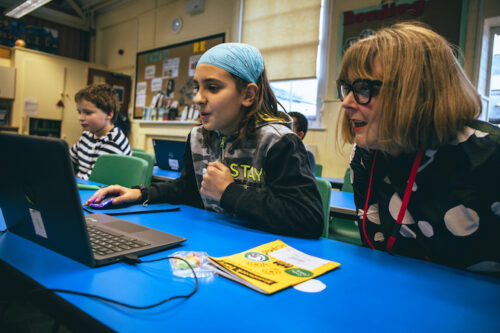
Professional software development rarely happens like this. For example, at the Raspberry Pi Foundation, our software engineers work collaboratively on design and often pair up to solve problems. Computing education research also has identified the importance of looking at computer programming through a collaborative lens. This viewpoint allows us to see computing as a subject with scope for collaborative group work in which students create useful applications together and are part of a community where programming has a shared social context [3].
Researching collaborative learning in the primary computing classroom
One teaching approach in computing that promotes collaborative learning is pair programming (a practice also used in industry). This is a structured way of working on programming tasks where learners are paired up and take turns acting as the driver or the navigator. The driver controls the keyboard and mouse and types the code. The navigator reads the instructions, supports the driver by watching out for errors in the code, and thinks strategically about next steps and solutions to problems. Learners swap roles every 5 to 10 minutes, to ensure that both partners can contribute equally and actively to the collaborative learning.
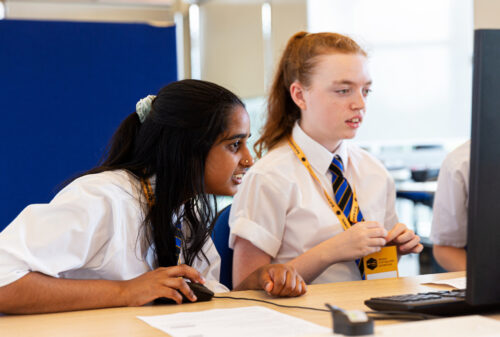
As one part of the Gender Balance in Computing programme, we designed a project to explore the effect of pair programming on girls’ attitudes towards computing. This project builds on research from the USA which suggests that solving problems collaboratively increases girls’ persistence when they encounter difficulties in programming tasks [4].
In the Pair Programming project, we worked with teachers of Year 4 (ages 8–9) and Year 6 (ages 10–11) in schools in England. From January to March 2020, we ran a pilot study with 10 schools and used the resulting teacher feedback to finalise the training and teaching materials for a full randomised controlled trial. Due to the coronavirus pandemic, we trained teachers in the pair programming approach using an online course instead of face-to-face training.
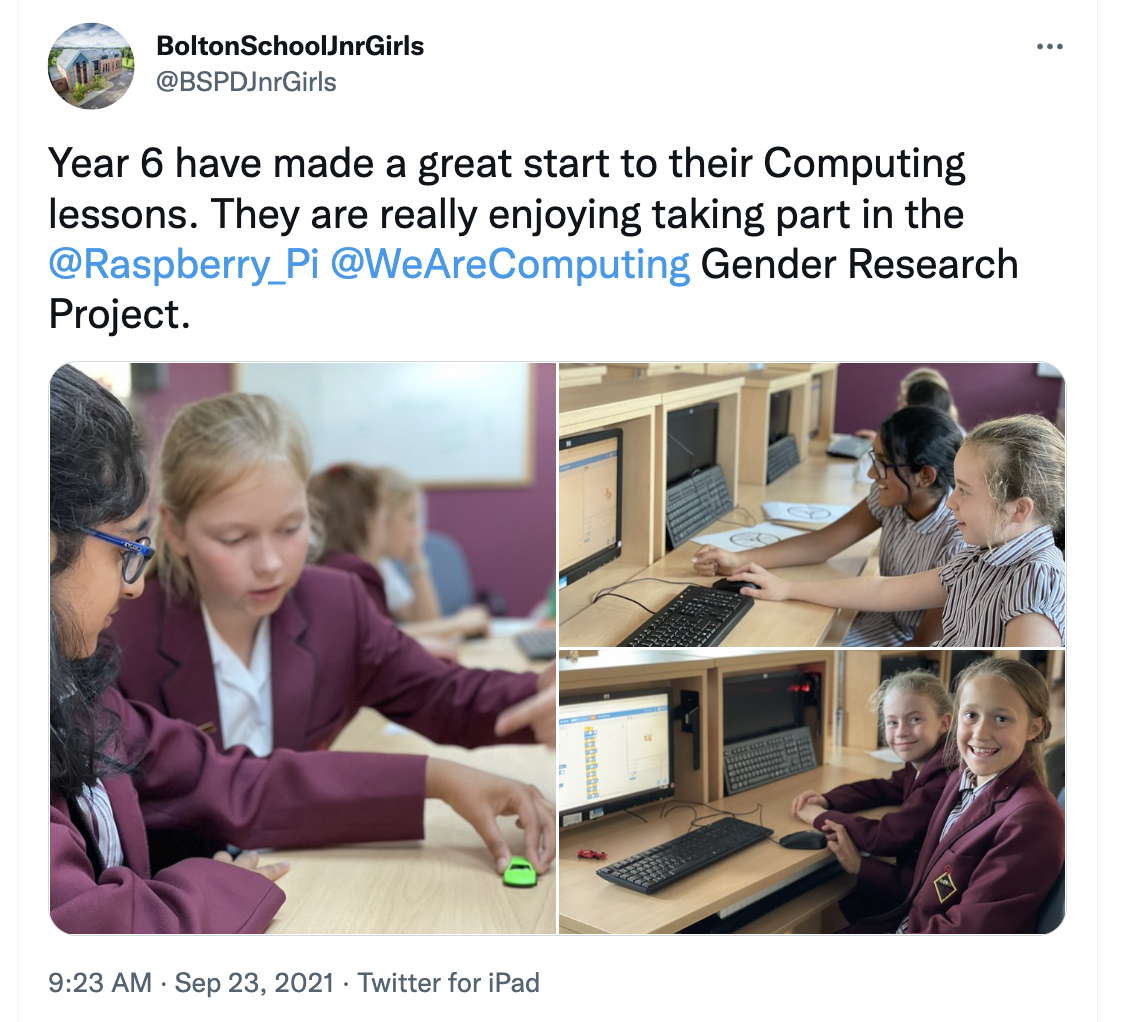
The randomised controlled trial ran from September to December 2021 with 97 schools. Schools were randomly allocated to either the intervention group and used the pair programming training and the scheme of work we designed, or to the control group and taught Computing in their usual way, not aware that we were investigating the effects of pair programming. Due to the coronavirus pandemic, our training of teachers in the pair programming approach had to take place via an online course instead of face to face.
Teachers in both groups delivered 12 weeks of Computing lessons, in which learners used Scratch programming to draw shapes and create animations. The lessons covered computing concepts from Key Stage 2 (ages 7–11), such as using sequences, selection, and repetition in programs, as well as digital literacy skills such as using technology respectfully.
What can we learn about pair programming from the study?
The findings about this particular intervention were limited by the amount of data the independent evaluators at BIT were able to collect amongst learners and teachers given the ongoing pandemic. BIT’s evaluation was primarily based on quantitative data collected from learners at the start and the end of the intervention. To collect the data, they used a validated instrument called the Student Computer Science Attitude Survey (SCSAS), which asks learners about their attitudes towards Computing. The evaluators compared the datasets gathered from the intervention group (who took part in pair programming lessons) and the control group (who took part in Computing lessons taught with a ‘business as usual’ model).
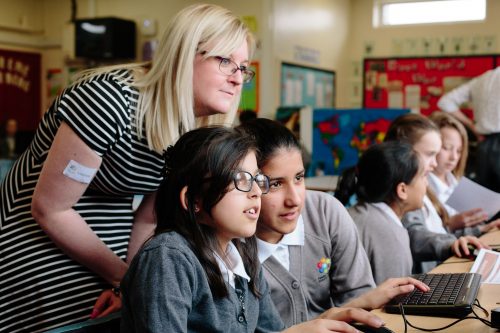
The evaluators’ data analysis found no statistically significant evidence that the pair programming approach positively affected girls’ attitudes towards computing or their intention to study computing in the future. The lack of statistically significant results, called a null result in research projects, can appear disappointing at first. But our work involves careful reflection and critical thinking about all outcomes of our research, and the result of this project is no exception. These are factors that may have contributed towards the result:
- The independent evaluators suggested that the intervention may lead to different findings if it were implemented again without the disruptions caused by the pandemic. One of their recommendations was to revert to our original planned model of providing face-to-face training to teachers delivering the pair programming approach, and we believe this would embed a deeper understanding of the approach.
- Our research built upon a prior study [4] that suggested a connection between pair programming and increased confidence about problem-solving in girls of a similar age. That study took place in a non-formal setting in an all-girls group, whereas our research was situated in formal education in mixed gender groups. It may be that these differences are significant.
- It may be that there is no causal link between using the pair programming approach and an increase in girls’ attitudes towards computing, or that the link may only become apparent over a longer time-scale, or that the pair programming approach needs to be combined with other strategies to achieve a positive effect.
The evaluators also gathered qualitative data by running teacher and learner interviews, and we were pleased that this data provided some rich insights into the benefits of using a pair programming approach in the primary classroom, and gave some promising indications of possible benefits for female learners in particular.
- Teachers spoke positively about the use of paired activities, and felt that having the defined roles of driver and navigator helped both partners to contribute equally to the programming tasks. Learners said that they enjoyed working in pairs, even though there could be some moments of frustration. Some of the teachers were even planning to integrate pair programming into future lessons. This suggests that the approach was effective both in engaging and motivating learners, as well as in facilitating the planned learning outcomes of the lessons, and that it can be used more widely in primary computing teaching.
“I don’t know why I’ve never thought to do computing like that, actually, because it’s a really good vehicle for the fact that there are two roles, clearly defined. There’s all your conversation, and knowledge comes through that, and then they’re both equally having a turn.” — Primary school teacher (report, p. 38)
“I like working with both [both as a partner and by yourself] because when you do pair programming, you’re collaborating with your partner, making links, and you have to tell them what to do. But if you have a really good idea and then they put the wrong thing in the wrong place, it’s quite annoying.” — Female learner (report, p. 40)
- Both teachers and learners felt that having the support of a partner boosted learners’ confidence, which echoes previous research in the field [5, 6]. In computing, boys more accurately assess their capabilities, whereas girls tend to underestimate their performance [7]. When learners feel a positive emotion such as confidence towards a subject, combined with a belief that they can succeed in tasks related to that subject, this shows self-efficacy [8]. Our findings suggest that, through the use of the pair programming approach, both boys and girls improved their sense of self-efficacy towards Computing, which is corroborated by quotes from learners themselves. This is interesting because a sense of self-efficacy in Computing is linked to the decisions to pursue further study in the subject [9]. More research could build on this observation.
“I do think that having that equal time to have a go at both, thinking of the girls I’ve got, will have helped my girls, because they lack a bit of confidence. They were learning very quickly that, ‘Actually, yes, we are sure. We can do this.’” — Primary teacher (report, p. 44)
- Werbung -“It might be easier to do pair programming [compared to ‘normal’ lessons] because if you’re stuck, your partner can be helpful.” — Female learner (report, p. 43)
Find out more about pair programming
- Download our Big Book of Computing Pedagogy a free PDF and read about pair programming on pages 58 and 59.
- Watch this short video that shows pair programming being used in a primary classroom.
- Read the evaluation report of the pair programming intervention, where you’ll also find more quotes from teachers and learners.
- Try the free training course on pair programming we designed and used for this project. It also includes links to the lesson plans that teachers worked with.
Collaboration in our research
We will continue to publish evaluation reports and our reflections on the other projects in the Gender Balance in Computing programme. If you would like to stay up-to-date with the programme, you can sign up to the newsletter.
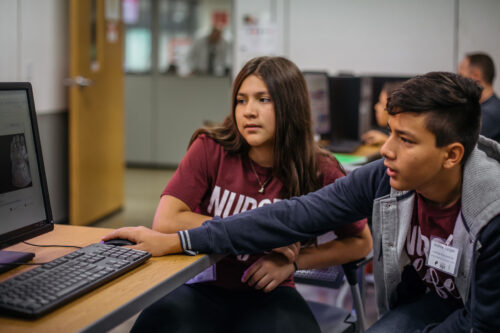
The insights gained from this trial will feed forwards into our future work. Through the process of working with schools on this project, we have increased our understanding of the process of research in educational settings in many ways. We are very grateful for the input from teachers who took part in the first stage of the trial, with whom we developed an effective co-production model for developing resources, a model we will use in future research projects. Teachers who took part in the second stage of the project told us that the resources we provided were of good quality, which demonstrates the success of this co-production approach to developing resources.
In our new Raspberry Pi Computing Education Research Centre, created with the University of Cambridge Department of Computer Science and Technology, we will collaborate closely with teachers and schools when implementing and evaluating research projects. You are invited to the free in-person launch event of the Centre on 20 July in Cambridge, UK, where we hope to meet many teachers, researchers, and other education practitioners to strengthen a collaborative community around computing education research.
References
[1] Goode, J., Estrella, R., & Margolis, J. (2018). Lost in Translation: Gender and High School Computer Science. In Women and Information Technology. https://doi.org/10.7551/mitpress/7272.003.0005
[2] Alexandria K. Hansen, Hilary A. Dwyer, Ashley Iveland, Mia Talesfore, Lacy Wright, Danielle B. Harlow, and Diana Franklin. 2017. Assessing Children’s Understanding of the Work of Computer Scientists: The Draw-a-Computer-Scientist Test. In Proceedings of the 2017 ACM SIGCSE Technical Symposium on Computer Science Education (SIGCSE ’17). Association for Computing Machinery, New York, NY, USA, 279–284. https://doi.org/10.1145/3017680.3017769
[3] Yasmin B. Kafai and Quinn Burke. 2013. The social turn in K-12 programming: moving from computational thinking to computational participation. In Proceeding of the 44th ACM technical symposium on Computer science education (SIGCSE ’13). Association for Computing Machinery, New York, NY, USA, 603–608. https://doi.org/10.1145/2445196.2445373
[4] Linda Werner & Jill Denning (2009) Pair Programming in Middle School, Journal of Research on Technology in Education, 42:1, 29-49. https://doi.org/10.1080/15391523.2009.10782540
[5] Charlie McDowell, Linda Werner, Heather E. Bullock, and Julian Fernald. 2006. Pair programming improves student retention, confidence, and program quality. Commun. ACM 49, 8 (August 2006), 90–95. https://doi.org/10.1145/1145287.1145293
[6] Denner, J., Werner, L., Campe, S., & Ortiz, E. (2014). Pair programming: Under what conditions is it advantageous for middle school students? Journal of Research on Technology in Education, 46(3), 277–296. https://doi.org/10.1080/15391523.2014.888272
[7] Maria Kallia and Sue Sentance. 2018. Are boys more confident than girls? the role of calibration and students’ self-efficacy in programming tasks and computer science. In Proceedings of the 13th Workshop in Primary and Secondary Computing Education (WiPSCE ’18). Association for Computing Machinery, New York, NY, USA, Article 16, 1–4. https://doi.org/10.1145/3265757.3265773
[8] Bandura, A. (1977). Self-efficacy: Toward a unifying theory of behavioral change. Psychological Review, 84(2), 191–215. https://doi.org/10.1037/0033-295X.84.2.191
[9] Allison Mishkin. 2019. Applying Self-Determination Theory towards Motivating Young Women in Computer Science. In Proceedings of the 50th ACM Technical Symposium on Computer Science Education (SIGCSE ’19). Association for Computing Machinery, New York, NY, USA, 1025–1031. https://doi.org/10.1145/3287324.3287389
Website: LINK
